Papers by Stephen Sturley
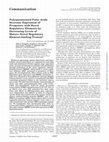
Journal of Biological Chemistry, Oct 1, 1998
Membrane physiology, plasma lipid levels, and intracellular sterol homeostasis are regulated by b... more Membrane physiology, plasma lipid levels, and intracellular sterol homeostasis are regulated by both fatty acids and cholesterol. Sterols regulate gene expression of key enzymes of cholesterol and fatty acid metabolism through proteolysis of the sterol regulatory elementbinding protein (SREBP), which binds to sterol regulatory elements (SRE) contained in promoters of these genes. We investigated the effect of fatty acids on SREdependent gene expression and SREBP. Consistent results were obtained in three different cell lines (HepG2, Chinese hamster ovary, and CV-1) transfected with SREcontaining promoters linked to the luciferase expression vector. We show that micromolar concentrations of oleate and other polyunsaturated fatty acids (C18:2-C22:6) dose-dependently (0.075-0.6 mmol) decreased transcription of SRE-regulated genes by 20-75%. Few or no effects were seen with saturated free fatty acids. Fatty acid effects on SRE-dependent gene expression were independent and additive to those of exogenous sterols. Oleate decreased levels of the mature sterol regulatory element-binding proteins SREBP-1 and-2 and HMG-CoA synthase mRNA. Oleate had no effect in sterol regulation defective Chinese hamster ovary cells or in cells transfected with mutant SRE-containing promoters. We hypothesize that unsaturated fatty acids increase intracellular regulatory pools of cholesterol and thus affect mature SREBP levels and expression of SREdependent genes.
Springer eBooks, 1993
Recombinant mammalian apolipoproteins have been expressed in a variety of cultured mammalian cell... more Recombinant mammalian apolipoproteins have been expressed in a variety of cultured mammalian cell lines (Reardon et al. 1986; Mallory et al. 1987; Blackhart et al. 1990; Yao et al. 1991), transgenic animals (Simonet et al. 1991), and bacteria (Vogel et al. 1985; Lalazar et al. 1988). These approaches have yielded considerable insight into the structure and function of several apolipoproteins but are rather limited for research or pharmaceutical purposes due to laborious technology or low yield often associated with these systems. This is particularly problematic if large scale production of biologically active lipoproteins for therapeutic purposes is to be attempted.
Nature Medicine, Apr 1, 2002
Protein Expression and Purification, Dec 1, 1996
ABSTRACT
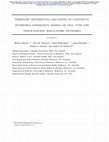
bioRxiv (Cold Spring Harbor Laboratory), May 19, 2023
Single-cell RNA-Seq (scRNA-seq) transcriptomics can elucidate gene regulatory networks (GRNs) of ... more Single-cell RNA-Seq (scRNA-seq) transcriptomics can elucidate gene regulatory networks (GRNs) of complex phenotypes, but raw sequencing observations only provide "snap-shots" of data and are inherently noisy. scRNA-seq trajectory inference has been utilized to solve for the missing observations, but disentangling complex dynamics of gene-gene interactions at different time points from aggregated data is a non-trivial task and computationally expensive. Here we describe our Non-Stiff Dynamic Invertible Model of CO-Regulatory Networks (NS-DIMCORN) to define the genetic nexus underpinning specific cellular functions using invertible warping of flexible multivariate Gaussian distributions by neural Ordinary differential equations. Our results yield a generative model with unbiased density estimation from RNA-seq read-count data only. This resulted in scalable time-flexible sampling of each gene's expression level thence allowing ab initio assembly of gene regulatory networks in specific cells. We demonstrate our proposed methodology is superior to the state-of-the-art algorithms in accurately recovering genome-wide functional interactions, whether from synthetic or empirical data. We optimized our algorithm for GPUbased implementation thereby further enhancing the utility of our proposed methodology in comparison to the ten benchmarked methods.
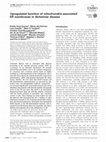
The EMBO Journal, Aug 14, 2012
Alzheimer disease (AD) is associated with aberrant processing of the amyloid precursor protein (A... more Alzheimer disease (AD) is associated with aberrant processing of the amyloid precursor protein (APP) by c-secretase, via an unknown mechanism. We recently showed that presenilin-1 and-2, the catalytic components of c-secretase, and c-secretase activity itself, are highly enriched in a subcompartment of the endoplasmic reticulum (ER) that is physically and biochemically connected to mitochondria, called mitochondria-associated ER membranes (MAMs). We now show that MAM function and ER-mitochondrial communication-as measured by cholesteryl ester and phospholipid synthesis, respectivelyare increased significantly in presenilin-mutant cells and in fibroblasts from patients with both the familial and sporadic forms of AD. We also show that MAM is an intracellular detergent-resistant lipid raft (LR)-like domain, consistent with the known presence of presenilins and c-secretase activity in rafts. These findings may help explain not only the aberrant APP processing but also a number of other biochemical features of AD, including altered lipid metabolism and calcium homeostasis. We propose that upregulated MAM function at the ER-mitochondrial interface, and increased cross-talk between these two organelles, may play a hitherto unrecognized role in the pathogenesis of AD.
Biochimica Et Biophysica Acta - Molecular And Cell Biology Of Lipids, Aug 1, 2019
The complexity of a monogenic neurodegenerative disease: More than two decades of therapeutic dri... more The complexity of a monogenic neurodegenerative disease: More than two decades of therapeutic driven research into Niemann-Pick type C disease
Genetics, Jul 13, 2023
Niemann-Pick type C (NP-C) disease is a rare lysosomal storage disease caused by mutations in NPC... more Niemann-Pick type C (NP-C) disease is a rare lysosomal storage disease caused by mutations in NPC1 (95% cases) or NPC2 (5% cases). These proteins function together in cholesterol egress from the lysosome, whereby upon mutation, cholesterol and other lipids accumulate causing major pathologies. However, it is not fully understood how cholesterol is transported from NPC1
The FASEB Journal, Apr 1, 2010

Arteriosclerosis, Thrombosis, and Vascular Biology, May 1, 2012
ACAT related enzyme 2 required for viability 1 (ARV1) was identified as a gene required for viabi... more ACAT related enzyme 2 required for viability 1 (ARV1) was identified as a gene required for viability in yeast in the absence of cholesterol esterification. ARV1 encodes a putative lipid transporter believed to be important in trafficking of lipids from the ER to the Golgi. ARV1 deficient yeast exhibit profound alterations in cholesterol, phospholipid, and sphingolipid metabolism, accompanied by a constitutively activated unfolded protein response and impaired GPI anchor synthesis. To study the role of ARV1 in mammalian lipid metabolism, we have generated mice with an adipose specific deletion of ARV1 using Cre/loxP technology with Cre expression driven by the Ap2 promoter. ARV1 adipose specific knockout (ASKO) mice exhibited significant reductions in plasma total cholesterol (↓21%, p < 0.05), HDL cholesterol (↓25%, p < 0.01), and phospholipid (↓17.6%, p < 0.05) levels, while fasting triglyceride levels were unaffected. ARV1 ASKO mice also had substantial reductions in epididymal adipose (WT: 0.41 +/- 0.07 g vs. KO: 0.10 +/- 0.07 g, p = 0.0002) and subcutaneous adipose tissue mass (WT: 0.32 +/- 0.03 g vs. KO: 0.11 +/- 0.08 g; p= 0.0002) on a chow diet. In contrast to nearly every other lipodystrophic mouse model, the reduced fat mass in these animals was paradoxically accompanied by improved glucose tolerance (WT AUC: 32,055 vs. KO AUC: 21,470 mg/dl*minutes, p<0.05). These data identify mammalian ARV1 as an important player in adipose tissue biology, and support an important role for adipose tissue in circulating lipoprotein metabolism.
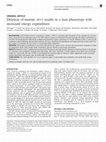
Nutrition & diabetes, Jan 19, 2015
ACAT-related enzyme 2 required for viability 1 (ARV1) is a putative lipid transporter of the endo... more ACAT-related enzyme 2 required for viability 1 (ARV1) is a putative lipid transporter of the endoplasmic reticulum that is conserved across eukaryotic species. The ARV1 protein contains a conserved N-terminal cytosolic zinc ribbon motif known as the ARV1 homology domain, followed by multiple transmembrane regions anchoring it in the ER. Deletion of ARV1 in yeast results in defective sterol trafficking, aberrant lipid synthesis, ER stress, membrane disorganization and hypersensitivity to fatty acids (FAs). We sought to investigate the role of Arv1 in mammalian lipid metabolism. Homologous recombination was used to disrupt the Arv1 gene in mice. Animals were examined for alterations in lipid and lipoprotein levels, body weight, body composition, glucose tolerance and energy expenditure. Global loss of Arv1 significantly decreased total cholesterol and high-density lipoprotein cholesterol levels in the plasma. Arv1 knockout mice exhibited a dramatic lean phenotype, with major reduction...

The FASEB Journal, 2015
A key component of eukaryotic lipid homeostasis is the esterification of sterols with fatty acids... more A key component of eukaryotic lipid homeostasis is the esterification of sterols with fatty acids by sterol O-acyltransferases (SOATs). The esterification reactions are allosterically activated by their sterol substrates, the majority of which accumulate at the plasma membrane. We demonstrate that in yeast, sterol transport from the plasma membrane to the site of esterification is associated with the physical interaction of the major SOAT, acylcoenzyme A:cholesterol acyltransferase (ACAT)-related enzyme (Are)2p, with 2 plasma membrane ATP-binding cassette (ABC) transporters: Aus1p and Pdr11p. Are2p, Aus1p, and Pdr11p, unlike the minor acyltransferase, Are1p, colocalize to sterol and sphingolipid-enriched, detergent-resistant microdomains (DRMs). Deletion of either ABC transporter results in Are2p relocalization to detergent-soluble membrane domains and a significant decrease (53-36%) in esterification of exogenous sterol. Similarly, in murine tissues, the SOAT1/Acat1 enzyme and activity localize to DRMs. This subcellular localization is diminished upon deletion of murine ABC transporters, such as Abcg1, which itself is DRM associated. We propose that the close proximity of sterol esterification and transport proteins to each other combined with their residence in lipid-enriched membrane microdomains facilitates rapid, high-capacity sterol transport and esterification, obviating any requirement for soluble intermediary proteins.
The EMBO Journal, 1986
Communicated by J.E.Davies (confers no phenotype. The immunity determinant may minimally consist ... more Communicated by J.E.Davies (confers no phenotype. The immunity determinant may minimally consist of the a domain and the N-terminal portion of-y. Two new models for immunity are considered, where either protoxin or a processed form of protoxin functions as the immunity determinant.
Science, 1997
Niemann-Pick type C (NP-C) disease, a fatal neurovisceral disorder, is characterized by lysosomal... more Niemann-Pick type C (NP-C) disease, a fatal neurovisceral disorder, is characterized by lysosomal accumulation of low density lipoprotein (LDL)–derived cholesterol. By positional cloning methods, a gene (NPC1)with insertion, deletion, and missense mutations has been identified in NP-C patients. Transfection of NP-C fibroblasts with wild-typeNPC1cDNA resulted in correction of their excessive lysosomal storage of LDL cholesterol, thereby defining the critical role of NPC1 in regulation of intracellular cholesterol trafficking. The 1278–amino acid NPC1 protein has sequence similarity to the morphogen receptor PATCHED and the putative sterol-sensing regions of SREBP cleavage-activating protein (SCAP) and 3-hydroxy-3-methyl-glutaryl coenzyme A (HMG-CoA) reductase.
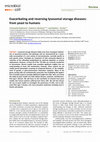
Microbial Cell, 2017
Lysosomal storage diseases (LSDs) arise from monogenic deficiencies in lysosomal proteins and pat... more Lysosomal storage diseases (LSDs) arise from monogenic deficiencies in lysosomal proteins and pathways and are characterized by a tissuewide accumulation of a vast variety of macromolecules, normally specific to each genetic lesion. Strategies for treatment of LSDs commonly depend on reduction of the offending metabolite(s) by substrate depletion or enzyme replacement. However, at least 44 of the ~50 LSDs are currently recalcitrant to intervention. Murine models have provided significant insights into our understanding of many LSD mechanisms; however, these systems do not readily permit phenotypic screening of compound libraries, or the establishment of genetic or gene-environment interaction networks. Many of the genes causing LSDs are evolutionarily conserved, thus facilitating the application of models system to provide additional insight into LSDs. Here, we review the utility of yeast models of 3 LSDs: Batten disease, cystinosis, and Niemann-Pick type C disease. We will focus on the translation of research from yeast models into human patients suffering from these LSDs. We will also discuss the use of yeast models to investigate the penetrance of LSDs, such as Niemann-Pick type C disease, into more prevalent syndromes including viral infection and obesity.

Genome and exome sequencing has been extensively successful in identifying disease causing gene m... more Genome and exome sequencing has been extensively successful in identifying disease causing gene mutations and variants in GWAS. However, there has been little success in deducing the pertinent genomic variants that significantly modify disease progression and fully account for phenotype. One reason is that current use of genome-wide association study (GWAS) utilize narrow sense heritability estimates and do not include assessment of epistasis and other components of broad-sense heritability1-2 . Here we report investigation of genetic variants that modify the causal gene of a monogenic disease and ultimately regulate its onset and progression in individuals. Niemann-Pick type C (NP-C) disease, a rare monogenic Mendelian disease, is one of more than 6,000 Mendelian diseases for which there is no cure. Most NP-C patients with the NPC1 gene mutation are diagnosed as late infants and die before or during adolescence, yet survival of some to adulthood provides a testbed for elucidating g...
Journal of Biological Chemistry, 2011
3 PA phosphatase is distinguished in catalytic activity from the lipid phosphate phosphatase enzy... more 3 PA phosphatase is distinguished in catalytic activity from the lipid phosphate phosphatase enzymes that dephosphorylate a broad spectrum of substrates (e.g. PA, lysoPA, and DAG pyrophosphate) by a distinct catalytic mechanism that does not require divalent cations (4, 12, 97, 98). 4 PAH1 was known previously by the designation SMP2 (99).

Uploads
Papers by Stephen Sturley